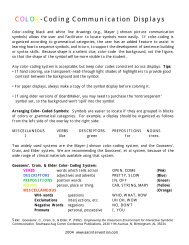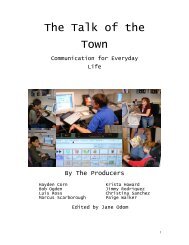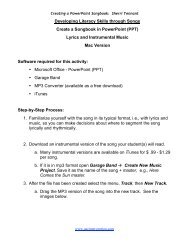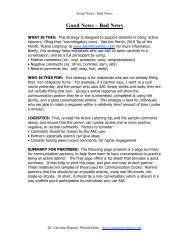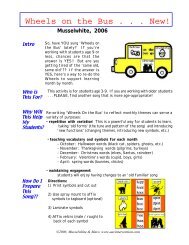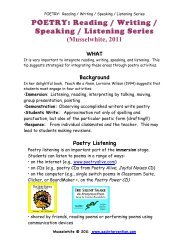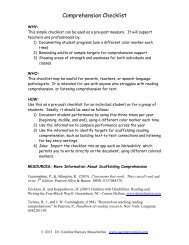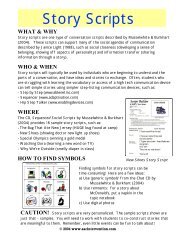Reading Comprehension: Predicting Using Names - AAC ...
Reading Comprehension: Predicting Using Names - AAC ...
Reading Comprehension: Predicting Using Names - AAC ...
Create successful ePaper yourself
Turn your PDF publications into a flip-book with our unique Google optimized e-Paper software.
<strong>Reading</strong> <strong>Comprehension</strong>:<strong>Predicting</strong> <strong>Using</strong> <strong>Names</strong>WHAT: This strategy is designed to help students make predictions using thenames of students in their class. It also helps teachers think about readingcomprehension lessons that focus on reading for just one purpose. In this firstexample, the purpose is predicting the best title of the book. This activity is afollow-up to writing an “About Me” book for each student.Overall Goal: After reading or listening to the book, choose the best title,based on the story, pictures, and the reader’s own background knowledge.WHO IS THIS FOR: This strategy gives students a chance to practice findingtheir names for authentic purposes. Thus, it is ideal for students in preschool orkindergarten, or individuals who are older, but still learning to identify theirnames.LOGISTICS:Before using this activity, each student would need to write an “All About Me”book. Each page should have something the about the student that others mayhave in common (e.g., what school, color hair, song he/she likes, boy or girl).For this comprehension activity, the pages with the student’s photo and nameshould be the last pages (or at least covered with a post-it).Before <strong>Reading</strong>:Build background knowledge – Talk with students about titles of books (andmovies and TV shows), and how the “title” is like the “name” of the book.Remind them of the “All About Me” books they wrote, and talk about they all havethe same title, so we need to think of new titles.Chart Predictions:Teacher writes names of students (possible story titles) on a chart, so they canrefer to the predictions during and after reading the story.
Choosing <strong>Names</strong> for Voting:Offer a choice, using photos, symbols, <strong>AAC</strong> devicesor PostIts. Students vote by selecting their names,which are displayed:a) Write names on PostIts while students watch,so they get another model of name-writingb) Name page or row on <strong>AAC</strong> devicec) Laminated student names on a choice boardd) Laminated student photos with names forstudents working on ID of photos.During <strong>Reading</strong>:State purpose clearly. Tell the students, “Listen so that we can choose the besttitle for this book.” The teacher reads the story (or a student uses a switch tostep forward and read an electronic version of the story to the group). Stop nomore than 2 times to remind students, “Remember, you’re listening to choosethe best title for this book.”Reviewing Predictions After <strong>Reading</strong>:• The teacher points to and reads each titleon the chart made before reading.• Each student votes for the title he or shethinks is best. For some groups, you mayneed to limit choices to two names. Placethe titles, e.g., “About Lisa” on the top of aVelcro voting chart (see Tip of the Month,January 2010 - Insta-Charting: Votingwith <strong>Names</strong>).• After voting on the title, the teacher guidesthe students back through the book to findthe words and/or pictures that helpedthem chose each of the titles. Describewhat is correct about ALL of the choicesstudents make (e.g., the second personshould have some items in common withthe selected person (e.g., same school,color hair, boy/girl, etc).• After completing the task, the teacherreveals the name of the author and guidesthe students back through the book to see ifthey would still vote for the same title.How To Extend Learning:Use the names for voting and charting eachpage of the book: Who lives in a house or an
apartment? Who is a boy/girl? Who likes American Idol or Glee?Read other books with names in them. Substitute one student for a character inthe book. Have students predict which student will have the same name as oneof the characters.Remember that reading comprehension tasks involve reading the whole storyand only stopping once or twice to remind students of the purpose. Ask morequestions after reading.Ideas for other stories:Just My Friend And Me book by Mercer MayerLooking at family photo albums, yearbooksStart to Finish Literacy Starters book: Trading Faceswww.donjohnston.comStories from Learning to Work by Attainment (Musselwhite & Richardson, 2009)www.attainmentcompany.com Samples include:‘Good News Bad News’ or ‘Next’ (Food Set)‘No Problem’ or ‘The Coke’ (Hospital Set)‘Perfect for the Prom’ or ‘Growing Pains’ (Garden Set)



